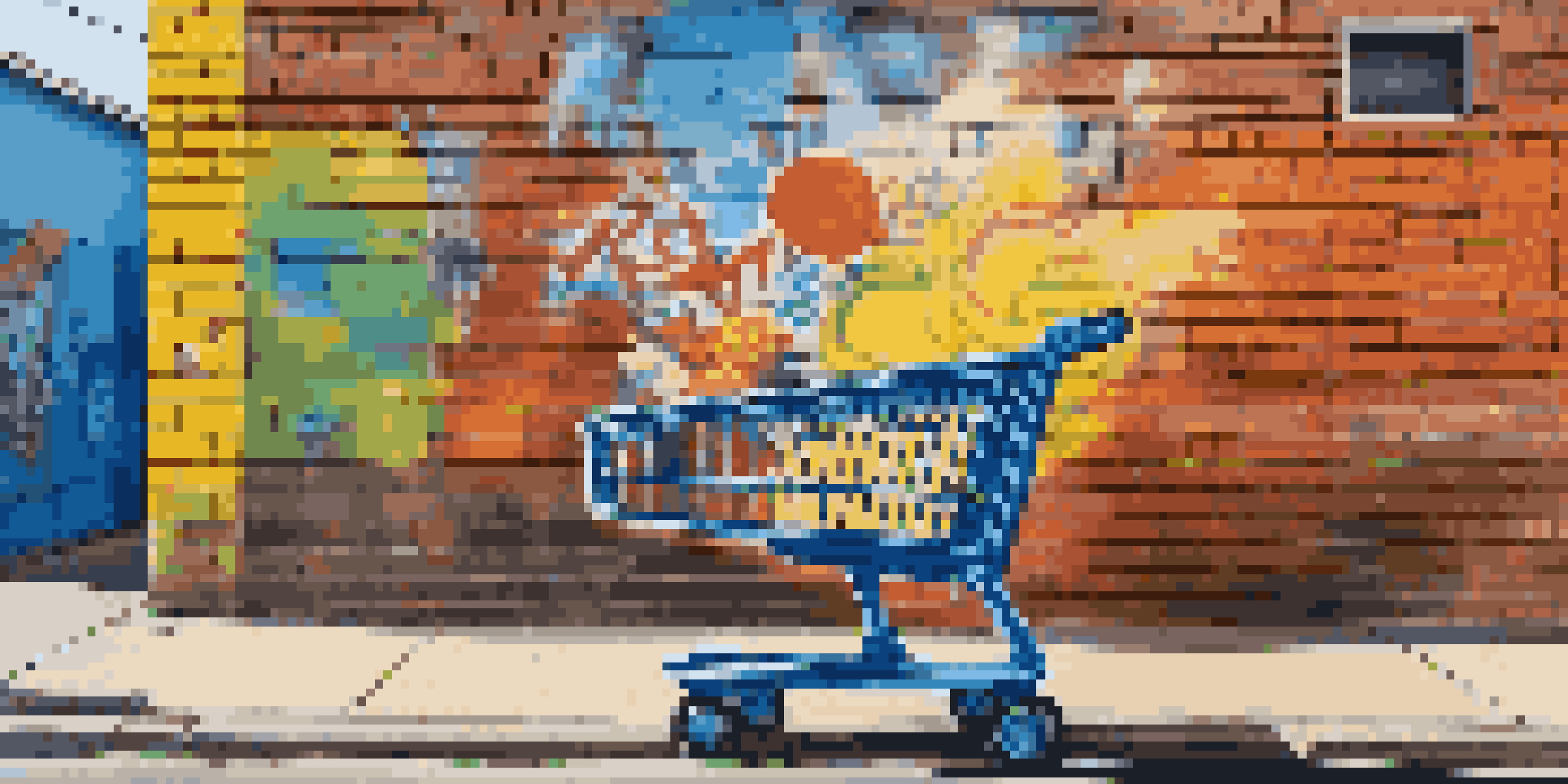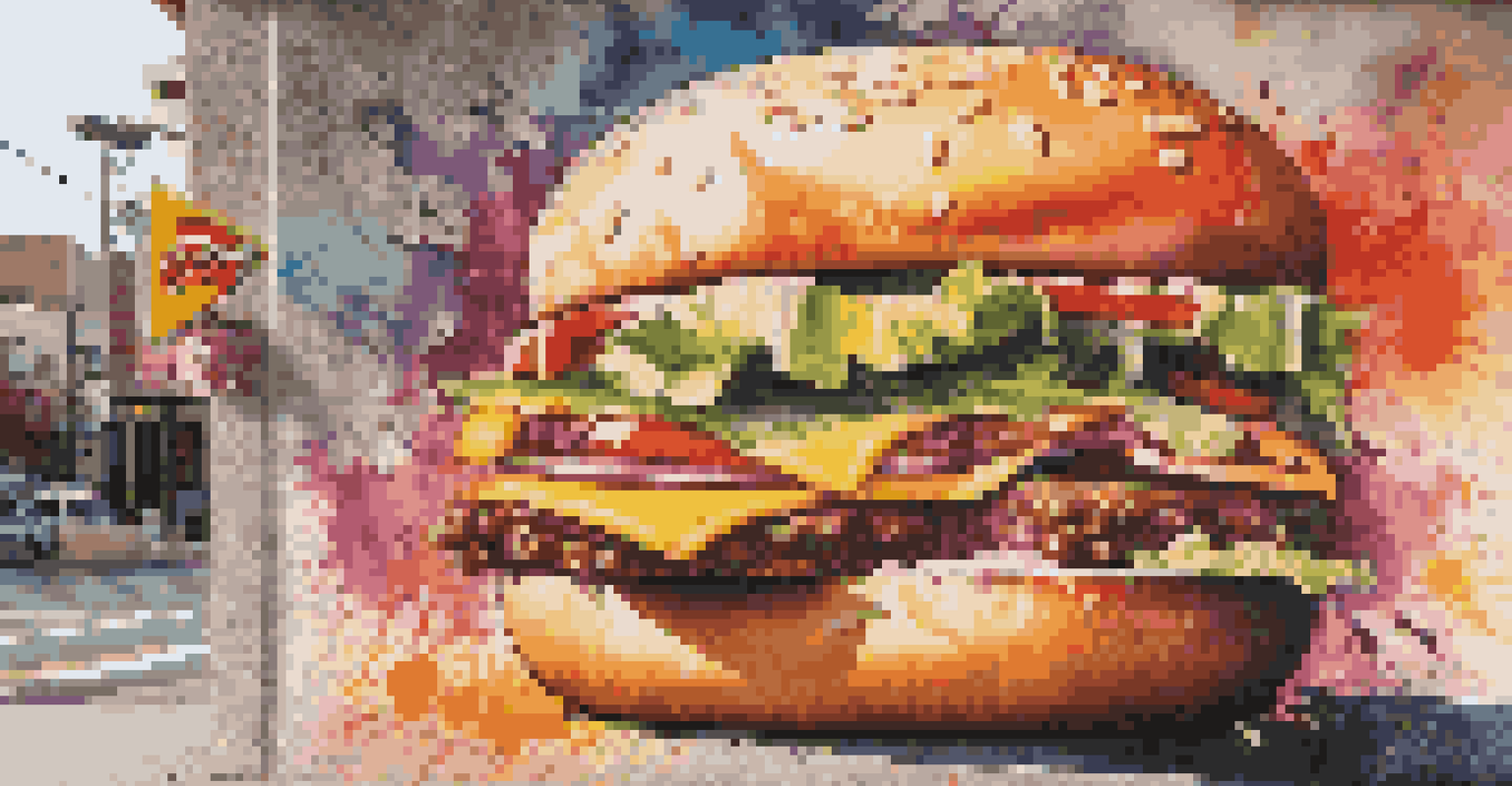Street Art and Consumerism: Critiques Through Creativity

Understanding the Intersection of Street Art and Consumerism
Street art, often seen as a rebellious form of expression, intersects intriguingly with consumerism. Artists use public spaces to comment on the materialism that permeates modern life, creating a dialogue that challenges societal norms. This intersection becomes a canvas for critique, highlighting the contrast between artistic freedom and commercial pressure.
Art is the most beautiful of all lies.
For example, think of a vibrant mural depicting a giant, sad-faced shopping cart. This imagery invites viewers to reflect on the emptiness that can accompany consumer culture. Instead of simply selling products, street art often aims to provoke thought and inspire change, making it a powerful tool for social commentary.
As urban environments become increasingly commercialized, street artists are stepping up to reclaim public spaces. They transform dull walls into thought-provoking exhibits, reminding us that art can be a form of resistance against rampant consumerism.
The Role of Street Artists as Social Commentators
Street artists often take on the role of modern-day philosophers, using their work to voice critiques of society. They challenge the status quo by addressing issues like inequality, environmental degradation, and rampant consumerism. Through their art, they encourage the public to engage with these pressing topics.

Consider Banksy, whose works often juxtapose playful imagery with serious messages about capitalism and consumer culture. His art serves as a reminder that creativity can be a powerful weapon against societal complacency. By placing these critical messages in public view, street artists invite conversations that might otherwise remain unspoken.
Street Art as Social Commentary
Street artists use their work to critique societal norms and provoke thought on issues like consumerism and inequality.
In this way, street art becomes more than just decoration; it becomes a form of activism. Artists draw attention to issues that matter, using their creativity to inspire change and encourage critical thinking in their audience.
Consumerism as a Canvas for Artistic Expression
The very essence of consumerism often becomes the subject of street art. Artists creatively reinterpret logos, advertisements, and products, showcasing the absurdity of materialism. By placing these symbols in unexpected contexts, they challenge the audience's perception of value and desire.
In a consumer-driven society, the greatest form of rebellion is to create something that challenges the norm.
For instance, a mural of a fast-food burger morphing into a piece of abstract art can spark debate about food culture and health. This playful yet poignant representation encourages viewers to reconsider their consumption habits while appreciating the artistic process. It's a fascinating blend of humor and critique that resonates deeply.
Thus, consumerism serves not only as a backdrop for street art but also as a rich source of inspiration. Artists leverage the very symbols of consumer culture to provoke thought and inspire dialogue about the choices we make in our lives.
The Impact of Digital Consumerism on Street Art
In today's digital age, consumerism has expanded to include online shopping and social media influence. This shift has significantly impacted street art, as artists now navigate a landscape where their work is often commodified and consumed digitally. The challenge lies in maintaining authenticity while engaging with these new platforms.
For example, an artist might create a stunning mural that gains viral attention online, leading to merchandise featuring their work. This commercialization can dilute the original message, making it essential for artists to find a balance between exposure and staying true to their artistic vision. The internet can be both a blessing and a curse.
Consumerism Inspires Artistic Expression
Artists creatively reinterpret symbols of consumer culture to challenge perceptions of value and desire.
Ultimately, street artists must adapt to the evolving consumer landscape, using social media to share their messages while remaining critical of the very systems they critique. This duality reflects the complexity of modern art and consumer culture.
Street Art Festivals: Celebrating Creativity Amid Consumerism
Street art festivals have emerged as vibrant celebrations of creativity, often standing in contrast to consumerism. These events bring together artists from around the world, transforming urban spaces into open-air galleries. They highlight the importance of community and the power of creativity to inspire change.
At these festivals, art becomes a communal experience, inviting spectators to engage directly with the work and the artists behind it. This interaction fosters a sense of belonging and encourages conversations about the messages conveyed through the art. It's a refreshing break from the commercialized art world, emphasizing creativity over consumerism.
Moreover, street art festivals often prioritize local culture and social issues, reinforcing the idea that art can be a vehicle for community empowerment. By celebrating creativity in this way, they remind us of the potential for art to inspire and unite us, even in a consumer-driven society.
The Evolution of Street Art and Its Critique of Materialism
Street art has evolved significantly over the years, transitioning from graffiti to a respected form of artistic expression. While it retains its roots in rebellion and self-expression, today's street art often incorporates critiques of materialism. This evolution reflects broader societal changes and the ongoing dialogue about the role of art in addressing pressing issues.
Artists are increasingly using their platforms to comment on the consequences of materialism, such as environmental degradation and social inequality. For instance, murals depicting polluted landscapes serve as stark reminders of the impact of consumer choices. These powerful images resonate with audiences, prompting them to consider their own consumption habits.
Digital Age Challenges Authenticity
The rise of digital platforms complicates the balance between exposure and maintaining authenticity in street art.
As street art continues to evolve, it remains a potent tool for critiquing materialism. Artists effortlessly blend creativity with social commentary, ensuring that their messages remain relevant in a constantly changing world.
The Future of Street Art in a Consumer-Driven Society
Looking ahead, the future of street art in a consumer-driven society presents both challenges and opportunities. As urban spaces become increasingly commercialized, artists must navigate the delicate balance between staying true to their message and engaging with the commercial aspects of their work. This dynamic landscape requires creativity and resilience.
Moreover, the rise of digital platforms and social media continues to shape the way street art is created, shared, and consumed. Artists can reach wider audiences than ever before, but they must also contend with the risk of their work being co-opted or commodified. The challenge lies in harnessing these tools while remaining authentic.

Ultimately, the future of street art will likely see a continued blending of creativity and critique. As artists respond to the ever-evolving consumer landscape, their work will undoubtedly inspire future generations to think critically about the world around them and the role of consumerism in shaping their lives.